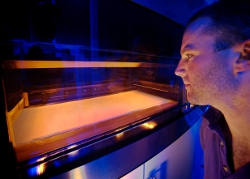Parallel adaptive laser fabrication system

Existing systems
Most laser fabrication systems use a single focussed laser beam to machine or fabricate material in a sequential fashion. The speed can be increased by using many focal spots in parallel. Parallelised fabrication with hundreds of spots has been implemented already using microlens arrays that create a multitude of focal spots, but this has the disadvantage that the array of foci is fixed and the foci cannot be controlled independently.
Alternatively, holographic patterns created by diffractive optical elements can split the laser beam into many foci. This can be more versatile than using a single focussed laser beam, if adaptive diffractive elements such as spatial light modulators are used. However, these suffer from wavelength dependence and hence chromatic aberration. This, along with other device limitations restricts the number of focal spots that can be created in parallel.
Combination method
Researchers at the University of Oxford have now developed a method for the adaptive control of multiple focal spot laser illumination combining both holographic beam shaping (using an adaptive optical element) and multiple focal spot generation (using a microlens array).
It combines both microlens arrays and holographic methods to create arrays of independently controllable focal spots. This will allow the arbitrary control of large numbers of foci in parallel and will lead to considerable increases in the versatility and speed of laser machining and fabrication.
Both the hybrid use of adaptive holographic diffractive elements and microlens arrays and also the holographic addressing schemes used to manipulate the individual spots are original innovations.
Other possible applications could be found in areas of optics that use adaptive control of light fields. These include optical tweezers and microscopy.
Patent status
A patent application covering this invention has been filed in the UK. Oxford University Innovation would like to talk to companies that develop laser-based manufacturing systems who are interested in developing this new method. Request more information if you would like to discuss this further.
about this technology

